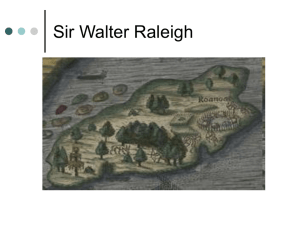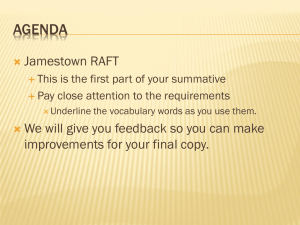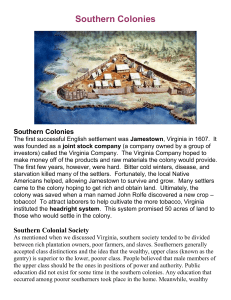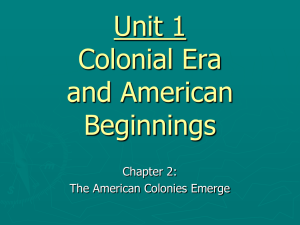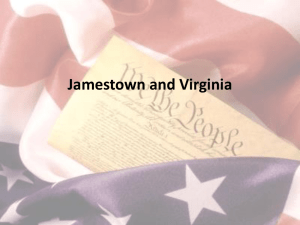The Planting of English America 1500-1733
advertisement
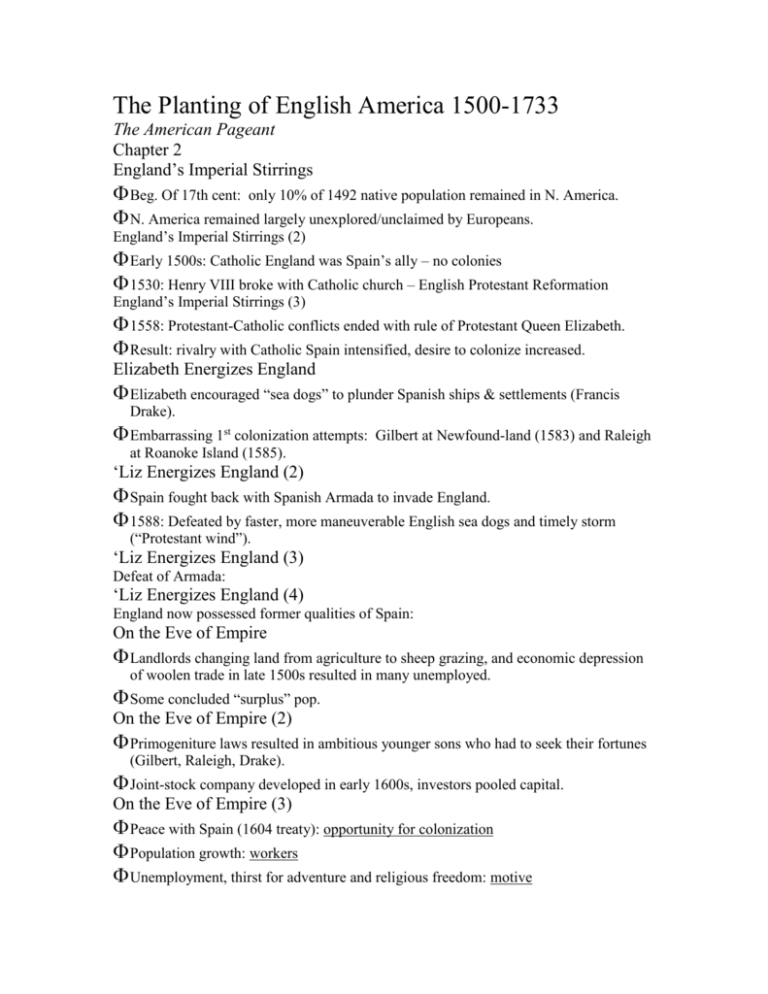
The Planting of English America 1500-1733 The American Pageant Chapter 2 England’s Imperial Stirrings Beg. Of 17th cent: only 10% of 1492 native population remained in N. America. N. America remained largely unexplored/unclaimed by Europeans. England’s Imperial Stirrings (2) Early 1500s: Catholic England was Spain’s ally – no colonies 1530: Henry VIII broke with Catholic church – English Protestant Reformation England’s Imperial Stirrings (3) 1558: Protestant-Catholic conflicts ended with rule of Protestant Queen Elizabeth. Result: rivalry with Catholic Spain intensified, desire to colonize increased. Elizabeth Energizes England Elizabeth encouraged “sea dogs” to plunder Spanish ships & settlements (Francis Drake). Embarrassing 1st colonization attempts: Gilbert at Newfound-land (1583) and Raleigh at Roanoke Island (1585). ‘Liz Energizes England (2) Spain fought back with Spanish Armada to invade England. 1588: Defeated by faster, more maneuverable English sea dogs and timely storm (“Protestant wind”). ‘Liz Energizes England (3) Defeat of Armada: ‘Liz Energizes England (4) England now possessed former qualities of Spain: On the Eve of Empire Landlords changing land from agriculture to sheep grazing, and economic depression of woolen trade in late 1500s resulted in many unemployed. Some concluded “surplus” pop. On the Eve of Empire (2) Primogeniture laws resulted in ambitious younger sons who had to seek their fortunes (Gilbert, Raleigh, Drake). Joint-stock company developed in early 1600s, investors pooled capital. On the Eve of Empire (3) Peace with Spain (1604 treaty): opportunity for colonization Population growth: workers Unemployment, thirst for adventure and religious freedom: motive Joint-stock co.: financial means Jamestown Seedling Virginia Co. of London (joint-stock) got charter from King James I for settlement. Goals: 1) gold, 2) passage to Indies Pressure on colonists to quickly strike it rich for investors Jamestown Seedling (2) Charter of Virginia Co. significant: guaranteed to settlers rights of Englishmen. Extended to other colonies also and became foundation for American liberties. Jamestown Seedling (3) 1607: 100 settlers (all men) landed on banks of James River (Chesapeake Bay area). Easy to defend, but unhealthful. Disaster: 40 settlers died en route, dozens died from disease, starvation. Jamestown Seedling (4) Game/fish were plentiful, but men were not used to fending for themselves and spent time looking for gold. 1608: Capt. John Smith saved it from collapse - “He who shall not work shall not eat.” Jamestown Seedling (5) Dec, 1607: Pocahontas/Smith incident helped preserve peace with Powhatan tribe, provided food for colonists. Colonists reduced to eating dogs, mice, exhumed bodies, even wives. Jamestown Seedling (6) Of 400 settlers who came to Va. by 1609, only 60 survived “starving time” winter of 1609-10. 1610: Attempted to abandon, but caught leaving by Lord De La Warr - ordered to return. Jamestown Seedling (7) De La Warr imposed military rule, fought natives. By 1625, Virginia contained only 1,200 of 8,000 who had settled. Most died from disease. Cultural Clash 1607: James River native tribes dominated by Powhatan – loosely affiliated into “Powhatan Confederacy.” 1610: De La Warr arrived with orders from Virginia Co. to conduct brutal campaign. Cultural Clash (2) 1614: First Anglo-Powhatan War ended with marriage of Pocahontas to John Rolfe. 1622: Indians renewed attacks, killing 347 settlers, incl. Rolfe. Va. Co. called for “perpetual war” – pushed natives west. Cultural Clash (3) 1644: Second Anglo-Powhatan War – one last effort to dislodge settlers. Natives defeated. 1646: Peace treaty banished natives from ancestral lands. 1685: English considered Powhatans extinct. Cultural Clash (4) Powhatans fell victim to disease, disorganization, disposability. Disposability: while Spaniards put natives to work in mines, the Powhatans served no economic purpose once Virginians could grow crops. VA: Child of Tobacco 1612: John Rolfe perfected tobacco growing – enormous demand from Europe Tobacco was hurriedly planted in streets of Jamestown, between graves, etc. VA: Child of Tobacco (2) Tobacco put VA on firm economic foundation, but was hard on soil resulting in thirst for new land. Promoted plantation system and demand for labor. VA: Child of Tobacco (3) 1619: Dutch ship sold 20 African slaves at Jamestown. Yet black slaves were too costly for most farmers, only 300 blacks in VA by 1650. 1700: blacks were 14% of pop. VA: Child of Tobacco (4) 1619: House of Burgesses was first representative assembly. 1624: James I revoked charter of bankrupt Virginia Co. – made VA a royal colony. Distrusted Burgesses – a “seminary of sedition.” MD: Catholic Haven 1634: founded by Lord Baltimore, prominent Catholic. Goals: financial profits, refuge for Catholics, large feudal estates for Catholic friends. Attracted others with land offers, mostly Protestant. MD: Catholic Haven (2) Conflicts arose between large land owners (Catholics) and small farmers (Protestants). Resulted in open rebellion near end of century. MD: Catholic Haven (3) MD prospered, like VA, with tobacco. Like VA, initially depended on indentured servants for labor. Black slaves came in large numbers toward end of 17th cent. MD: Catholic Haven (4) Initially, MD offered unusual freedom of worship. However, surge of Protestants threatened Catholics’ freedom. 1649: Act of Toleration limited freedom only to Christians – protecting Catholics. West Indies Early 1600s: Weaker Spain was losing grip on much of Caribbean Mid 1600s: England claimed several islands, incl. Jamaica Sugar: basis of W. Indian economy West Indies (2) Sugar vs. Tobacco West Indies (3) Result: Wealthy sugar growers imported 250,000 black slaves 1640-1690. 1700: Blacks outnumbered whites 4:1 Needed control: Barbados slave code of 1661 West Indies (4) Slave code denied basic rights, prescribed vicious punishments. 1670: Sugar growing crowded out small farmer: English settlers from Barbados arrived in Carolina with slaves, slave code. West Indies (5) 1696: Carolina adopts version of Barbados slave code, sets pattern for future colonies’ slave relations. Colonizing the Carolinas 1640-60: Civil wars in England (Charles I, Cromwell) interrupted colonization. 1660: Charles II to throne (“Restoration” period), led to renewed colonization with increased royal involvement. Colonizing the Carolinas (2) 1670: Carolina founded by 8 nobles who desired to grow food for sugar islands, and export wine, silk, olive oil. Prospered by trading with sugar islands and capturing/ trading Indian slaves Colonizing the Carolinas (3) 1707: Savannah Indians ended slave trading alliance with Carolinians. attacked in response, removing tribes of coastal Carolina by 1710. Colonizing the Carolinas (4) Rice became principal export crop. Settlers Colonists paid high prices for W. African slaves experienced with rice – benefit: blacks were immune to malaria. 1710: Africans were majority. Colonizing the Carolinas (5) Charleston became busiest seaport in South, home to many aristocratic families who did not get inheritance. Occasional conflict with Catholic Spaniards in Florida Emergence of N. Carolina Area south of Virginia was home to rejects from Virginia society, often “squatters.” Reputation as uncivilized, developed strong resistance to authority. Emergence of N. Carolina (2) Caught between aristocratic societies of VA and southern Carolina, friction developed. 1712: Formally separated With Rhode Island, regarded as most democratic, independent of colonies. Georgia: Buffer Colony 1733: Founded (last of 13) Goal: Protect more valuable Carolinas against Spaniards (Florida) and French (Louisiana). Only one of 13 col. to receive cash subsidies from England. Georgia: Buffer Colony (2) Founded by philanthropists to provide haven for debtors. Initially kept slavery out. James Oglethorpe: dynamic soldier-statesman repelled Spanish attacks, mortgaged own personal fortune. Georgia: Buffer Colony (3) All Christians except Catholics had freedom of worship Development of plantation economy slowed by unhealthy climate, restrictions on slavery, Spanish attacks. Plantation Colonies Maryland, Virginia, N. & S. Carolina and Georgia shared certain characteristics: Plantation Colonies (2) Shared characteristics (cont’d):

